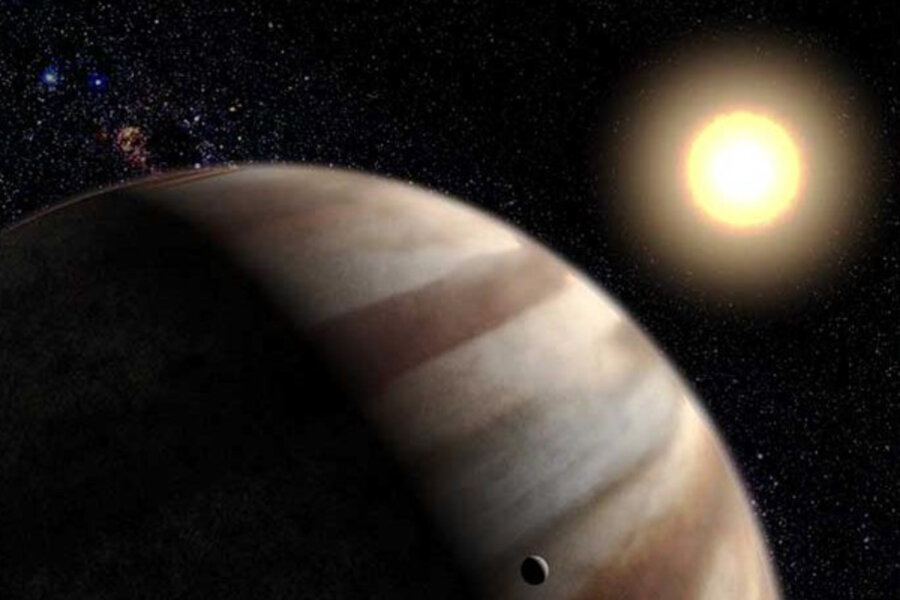Astronomers use an old trick to open new window on extrasolar planets
Loading...
A method astronomers have used for nearly 20 years to indirectly find planets orbiting other stars has for the first time been used to take the direct measure of an extrasolar planet itself.
The approach not only yields precise estimates of a planet's mass, a critical piece of information that can help determine a planet's bulk composition. It also can reveal its orbital inclination. And perhaps most important, it could allow astronomers to study atmospheres of more extrasolar planets than ever before.
The reason: The technique doesn't require a star to backlight a planet's atmosphere as the planet passes in front of its star. Until now, this kind of backlighting, during what's known as a transit, has provided the only window astronomers have had on the make-up of an extrasolar planet's atmosphere. And the number of transiting planets so far is only about one-third the number of planets discovered by two international teams of astronomers who used this approach and whose findings are published this month.
The orb the teams observed, known as tau Bootis b, was discovered in 1996 by a group led by astronomer Geoffrey Marcy at the University of California at Berkeley. It orbits a star nearly 51 light-years from Earth in the Northern-Hemisphere constellation Bootes.
Marcy's team found tau Bootis b via the slight wobble it imparted to its host star's spectrum as it orbits. As the planet swings around its star and its gravity tugs the star away from the viewer, it slides the star's bar-code-like chemical signature toward the red end of the spectrum. As the planet continues its orbit and tugs the star toward the viewer, the spectrum shifts toward the blue end. Over multiple orbits, the star's spectrum "wobbles" from blue to red and back.
The idea to use this approach to detect a planet directly is an old one, notes Simon Albrecht, an astronomer at the Massachusetts Institute of Technology in Cambridge, Mass., and a member of one of the two teams. His group was led by Matteo Brogi with the Leiden Observatory in the Netherlands. The other team was led by Florian Rodler, with the Institute of Space Science in Barcelona.
All it needed was the right combination of technology and a target close enough and bright enough to pursue. Tau Bootis b fit the latter requirement. For hardware, both teams used a new, exquisitely sensitive near-infrared spectrometer bolted to the back end of one of four eight-meter telescopes that make up the Very Large Telescope array. The facility, run by the European Southern Observatory, is located on a mountaintop in the Atacama Desert of northern Chile.
Hunting for the tell-tale signs of chemicals that are revealed as the star’s light interacts with the atmosphere, the teams found that the planet's atmosphere appears to be dominated by carbon monoxide. The spectrometer revealed carbon monoxide's spectral bar code with enough precision to uncover the spectrum’s wobble as the planet orbits. From the magnitude of the wobble, the teams calculated the planet's so-called radial velocity – the pace at which it appears to move back and forth. Both teams had a good handle on the star's mass. Knowing the radial velocity for the planet and the star, and knowing the star's mass, the team estimated the planet's mass with math a junior high-school student would recognize.
Dr. Rodler’s team found that tau Bootis b tipped the scales at 5.6 times Jupiter's mass. Dr. Brogi's team's estimate yielded 5.95 times Jupiter's mass. One reason for the discrepancy might be traced to the amount of telescope time each team received – 18 hours for Brogi's team versus six hours for Rodler’s group. Typically, the more time the spectrometer has to build up the data, the more precise the measurement.
In addition to using the radial-velocity technique to derive mass with a precision once the province of the transit approach, Brogi's team also used the spectra to build a picture of changes in the atmosphere's temperature with height.
Observations of a handful of other extrasolar planet atmospheres with the Spitzer Space Telescope have shown that temperatures are hottest at the top of the atmospheres of so-called hot Jupiters – gas giants orbiting very close to their host stars.
Tau Bootis b, which orbits its star once every 3.3 days, seems to be an oddball. Brogi's team's analysis suggests no such heating at the top of the atmosphere. Theorists have suggested this could happen if the planet is orbiting a star prone to frequent energetic outbursts. Frequent exposure to increased levels of high-energy radiation from the star could strip away heat-absorbing elements, including titanium oxide, from the top layers of a planet's atmosphere.
Tau Bootis, at roughly 1.3 times the mass of the sun, seems to be one such active star.
Brigi's team's data also yielded an inclination to the planet's orbit – something that has been a subject of debate. The answer: 44.5 degrees off an imaginary line padding through the star's equator.
The team's efforts collectively represent "a great result," says Dimitar Sasselov, a researcher studying extrasolar planets at the Harvard-Smithsonian Center for Astrophysics in Cambridge, Mass.
"The success of the CO technique, from the ground no less, is a welcome addition to our exoplanet study toolbox," he says. "Tau Bootis b has always been somewhat of an odd beast. I think it tells us something about the secret lives of super-massive planets."
Brogi's team's results are set for publication in Thursday's issue of the journal Nature. Rodler’s team's work was published June 18 in Astrophysical Journal Letters.







